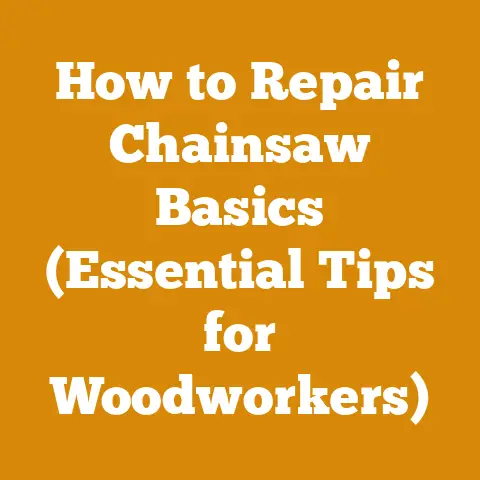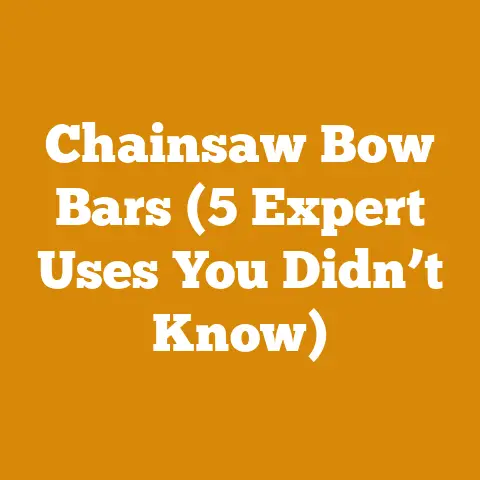Husqvarna 3120xp Chainsaw Price (5 Pro Tips for Woodcutters)
Aha! I remember the day I first laid eyes on the Husqvarna 3120XP. It was at a logging competition, and the sound of that saw ripping through a massive log was like music. I knew right then, I needed to understand everything about it. Not just its power, but its price, its capabilities, and how to truly master it. Today, I’m going to share everything I know about the Husqvarna 3120XP, focusing on its price and offering five pro tips to elevate your woodcutting game.
Understanding the Husqvarna 3120XP Chainsaw and Its Price
The Husqvarna 3120XP is a legend in the logging world. It’s known for its raw power, durability, and ability to tackle the biggest trees. But that power comes at a price, both literally and figuratively.
What Makes the 3120XP Special?
This chainsaw isn’t your average homeowner model. It’s built for professional loggers and those who demand the absolute best. Here’s a breakdown of its key features:
- Engine Size: Typically around 118.8 cc, delivering incredible power.
- Power Output: Expect around 6.2 kW (8.4 hp), allowing it to handle massive timber.
- Bar Length: Can accommodate bars from 20 inches to 42 inches, depending on the job.
- Weight: A hefty saw, usually around 23 lbs (10.4 kg) without fuel and bar.
- Durability: Built with high-quality components to withstand harsh conditions.
The Price Factor: New vs. Used
The price of a Husqvarna 3120XP can vary significantly depending on whether you’re buying new or used.
- New: Expect to pay anywhere from $1,500 to $2,000 or more, depending on the retailer, location, and any included accessories.
- Used: Used models can range from $800 to $1,500, depending on their condition, age, and how well they’ve been maintained.
Factors Affecting the Price:
- Retailer: Prices can vary between online retailers, local dealers, and auction sites.
- Location: Prices might be higher in areas with limited availability or high demand.
- Condition: A well-maintained used saw will command a higher price than one that’s been neglected.
- Accessories: A package deal that includes extra chains, bars, or carrying cases will likely cost more.
- Warranty: A new saw will come with a manufacturer’s warranty, while a used saw might not.
My Experience: I once found a used 3120XP at an auction for $900. It needed some TLC – a new chain, carburetor cleaning, and some fresh fuel lines – but after a few hours of work, it ran like a champ. It was a steal!
Is the 3120XP Worth the Investment?
For professional loggers or those who regularly fell large trees, the Husqvarna 3120XP is often a worthwhile investment. Its power and durability can save time and reduce downtime. However, for occasional use or smaller jobs, a less expensive saw might be a better choice.
Consider these questions:
- How often will you use the saw?
- What size trees will you be felling?
- What’s your budget?
- Do you have the physical strength to handle a heavy saw?
Takeaway: The Husqvarna 3120XP is a powerful and durable chainsaw, but its price reflects its professional-grade capabilities. Carefully consider your needs and budget before making a purchase.
Pro Tip #1: Mastering the Felling Cut with the 3120XP
Felling a tree safely and efficiently is paramount, especially when wielding a powerhouse like the 3120XP. I’ve seen too many accidents caused by improper felling techniques. Here’s my approach:
The Anatomy of a Felling Cut
The felling cut consists of three primary cuts: the undercut, the back cut, and the hinge.
- Undercut: A wedge-shaped cut on the side of the tree facing the direction you want it to fall. It typically consists of a horizontal cut followed by an angled cut meeting the horizontal cut.
- Back Cut: A horizontal cut on the opposite side of the tree from the undercut, leaving a hinge of wood between the two cuts.
- Hinge: The uncut wood between the undercut and the back cut. It controls the direction of the fall.
Step-by-Step Felling Procedure
- Assess the Tree and Surroundings: Before making any cuts, evaluate the tree for lean, wind direction, and any obstacles in the path of the fall (power lines, other trees, etc.). Clear the area around the base of the tree.
- Plan Your Escape Route: Identify two escape routes at a 45-degree angle away from the expected direction of the fall.
- Make the Undercut: The undercut should be about one-third of the tree’s diameter. Ensure the horizontal and angled cuts meet precisely.
- Make the Back Cut: Start the back cut slightly above the horizontal cut of the undercut. Leave a hinge of appropriate thickness (typically 1-2 inches, depending on tree size and species).
- Insert Wedges (If Needed): If the tree is leaning in the wrong direction or if there’s a risk of the saw pinching, insert felling wedges into the back cut before completing it.
- Complete the Back Cut: Finish the back cut, leaving the hinge intact.
- Retreat Safely: As the tree begins to fall, shout a warning (“Timber!”) and retreat quickly along your planned escape route.
Understanding Hinge Wood
The hinge is the key to controlling the fall. Too little hinge wood, and the tree might fall unpredictably. Too much, and the tree might barber chair (split upwards from the back cut). The ideal hinge thickness depends on the tree’s diameter and species.
Example: For a 20-inch diameter pine tree, a 1.5-inch hinge is generally sufficient. For a 30-inch oak, you might need a 2-inch hinge.
Common Mistakes to Avoid
- Cutting Too Deep: Avoid cutting too deep into the tree, which can weaken it and make it fall unpredictably.
- Ignoring Lean: Always account for the tree’s natural lean when planning your felling cut.
- Failing to Clear the Area: Clear any brush or debris that could obstruct your escape route.
- Neglecting Wedges: Use felling wedges whenever there’s a risk of the saw pinching or the tree leaning in the wrong direction.
- Not Using Proper PPE: Always wear a helmet, eye protection, hearing protection, and chainsaw chaps.
My Story: I once witnessed a logger who skipped the undercut on a large oak. The tree barber-chaired, sending a huge splinter of wood flying towards him. He was lucky to escape with minor injuries. That day, I learned the importance of following proper felling procedures.
Takeaway: Mastering the felling cut is crucial for safety and efficiency. Practice proper techniques, always assess the tree and surroundings, and never compromise on safety.
Pro Tip #2: Optimizing Chain Selection and Maintenance for the 3120XP
The chain is the heart of your chainsaw. Choosing the right chain and maintaining it properly will significantly impact your cutting speed, efficiency, and safety.
Understanding Chain Types
There are several types of chainsaw chains, each designed for specific applications.
- Full Chisel: Aggressive cutting, ideal for clean wood. Requires more skill to sharpen.
- Semi-Chisel: A good compromise between cutting speed and durability. Easier to sharpen than full chisel.
- Low-Profile (Micro-Chisel): Designed for smaller saws. Less aggressive cutting, but safer for beginners.
- Ripping Chain: Specifically designed for cutting wood lengthwise (milling).
For the 3120XP, I recommend using a full chisel or semi-chisel chain, depending on your skill level and the type of wood you’re cutting.
Chain Pitch and Gauge
Chain pitch refers to the distance between the rivets on the chain. Chain gauge refers to the thickness of the drive links that fit into the guide bar groove. It’s crucial to use the correct pitch and gauge for your saw and bar.
The Husqvarna 3120XP typically uses a .404″ pitch chain with a .063″ gauge. Always consult your owner’s manual to confirm the correct specifications.
Sharpening Your Chain
A sharp chain is essential for efficient cutting and safety. A dull chain requires more force, increasing the risk of kickback.
Tools for Sharpening:
- Round File: Use a round file of the correct size (typically 7/32″ for a .404″ pitch chain).
- File Guide: A file guide helps maintain the correct filing angle and depth.
- Depth Gauge Tool: Used to adjust the depth gauges (rakers) on the chain.
Sharpening Procedure:
- Secure the Chain: Use a vise or a chainsaw stand to hold the chain securely.
- File the Cutters: File each cutter at the correct angle (typically 30-35 degrees), using smooth, consistent strokes.
- Adjust the Depth Gauges: Use a depth gauge tool to lower the depth gauges slightly below the top of the cutters.
- Check for Consistency: Ensure all cutters are sharpened to the same length and angle.
My Tip: I always sharpen my chain after every tank of fuel. It only takes a few minutes, and it keeps the saw cutting efficiently.
Chain Maintenance
- Clean the Chain: Regularly clean the chain with solvent to remove sap and debris.
- Lubricate the Chain: Use a high-quality bar and chain oil to keep the chain lubricated.
- Check Chain Tension: Maintain proper chain tension to prevent the chain from derailing or binding.
- Replace Worn Chains: Replace the chain when it becomes excessively worn or damaged.
Takeaway: Chain selection and maintenance are crucial for optimal performance and safety. Choose the right chain for your application, sharpen it regularly, and keep it properly lubricated.
Pro Tip #3: Mastering Bucking Techniques with the 3120XP
Bucking is the process of cutting a felled tree into smaller, manageable lengths. With the 3120XP’s power, it’s tempting to just muscle through, but proper technique is key to safety and efficiency.
Understanding Compression and Tension
When bucking a log, the wood fibers are either in compression (being squeezed together) or tension (being pulled apart). Understanding these forces is crucial to prevent the saw from pinching.
- Compression: The side of the log where the wood fibers are being squeezed together.
- Tension: The side of the log where the wood fibers are being pulled apart.
The goal is to cut on the tension side first to relieve the stress before cutting on the compression side.
Bucking Techniques
- Log Supported at Both Ends: Make a cut one-third of the way through the log on the compression side (top). Then, roll the log over and finish the cut from the tension side (top).
- Log Supported at One End: Make a cut one-third of the way through the log on the tension side (bottom). Then, finish the cut from the compression side (top).
- Log Supported in the Middle: Make a cut one-third of the way through the log on the tension side (top). Then, finish the cut from the compression side (top).
Preventing Pinching
- Use Wedges: If there’s a risk of pinching, insert wedges into the cut to keep it open.
- Cut in Stages: Make multiple shallow cuts instead of one deep cut.
- Maintain Proper Chain Tension: A loose chain is more likely to pinch.
- Avoid Cutting in the Dirt: Dirt can dull the chain and increase the risk of kickback.
Using a Cant Hook
A cant hook is a valuable tool for rolling logs and positioning them for bucking. It can save you a lot of back strain and make the job safer.
My Cant Hook Story: I remember one time I was bucking a massive oak log without a cant hook. I spent hours struggling to roll it, and I ended up with a sore back for days. Now, I never buck a log without a cant hook.
Common Mistakes to Avoid
- Cutting Blindly: Always assess the log before making any cuts.
- Ignoring Compression and Tension: Cutting on the compression side first can lead to pinching and kickback.
- Overreaching: Avoid reaching too far to make a cut. Reposition yourself or the log.
- Cutting with a Dull Chain: A dull chain requires more force and increases the risk of kickback.
Takeaway: Mastering bucking techniques is essential for safety and efficiency. Understand compression and tension, use proper cutting techniques, and always use a cant hook when necessary.
Pro Tip #4: Fuel and Oil Management for Peak 3120XP Performance
The Husqvarna 3120XP demands the right fuel and oil to perform at its best and ensure longevity. Skimping on these can lead to costly repairs and reduced performance.
Fuel Requirements
The 3120XP, like most modern chainsaws, requires a mixture of gasoline and two-stroke oil.
- Gasoline: Use high-quality gasoline with an octane rating of 89 or higher. Avoid using gasoline that contains ethanol, as it can damage the engine. If you must use ethanol-blended fuel, use a fuel stabilizer.
- Two-Stroke Oil: Use a high-quality two-stroke oil specifically designed for air-cooled engines. Husqvarna recommends their own brand of two-stroke oil, but other reputable brands are also acceptable.
- Mixing Ratio: The recommended mixing ratio is typically 50:1 (50 parts gasoline to 1 part two-stroke oil). Always follow the manufacturer’s recommendations.
My Fueling Ritual: I always mix my fuel in a dedicated fuel can using a measuring container to ensure the correct ratio. I also label the can with the date and mixing ratio to avoid confusion.
Bar and Chain Oil
Using the right bar and chain oil is crucial for keeping the chain lubricated and preventing wear.
- Viscosity: Use a bar and chain oil with a viscosity appropriate for the temperature. In cold weather, use a thinner oil. In hot weather, use a thicker oil.
- Tackifiers: Look for a bar and chain oil that contains tackifiers, which help the oil adhere to the chain and bar.
- Biodegradable Options: Consider using a biodegradable bar and chain oil to reduce your environmental impact.
Fuel and Oil Storage
Proper storage of fuel and oil is essential for safety and preventing degradation.
- Fuel: Store fuel in a tightly sealed container in a cool, dry, and well-ventilated area. Avoid storing fuel near heat sources or open flames.
- Oil: Store oil in a tightly sealed container in a cool, dry place.
- Shelf Life: Gasoline has a limited shelf life (typically 3-6 months). After that, it can degrade and cause engine problems. Two-stroke oil can also degrade over time, so it’s best to use fresh oil.
Common Mistakes to Avoid
- Using the Wrong Fuel: Using gasoline with a low octane rating or containing ethanol can damage the engine.
- Using the Wrong Oil: Using motor oil or other types of oil instead of two-stroke oil can cause engine damage.
- Mixing Fuel Improperly: Using the wrong mixing ratio can lead to engine problems.
- Storing Fuel Improperly: Storing fuel in a hot or poorly ventilated area can cause it to degrade.
Takeaway: Proper fuel and oil management are crucial for the performance and longevity of your Husqvarna 3120XP. Use high-quality fuel and oil, mix them properly, and store them safely.
Pro Tip #5: Mastering Preventative Maintenance for the 3120XP
The Husqvarna 3120XP is a robust machine, but like any tool, it requires regular maintenance to keep it running smoothly. Preventative maintenance is far cheaper than repairs!
Daily Maintenance
- Check Chain Tension: Ensure the chain is properly tensioned.
- Clean the Air Filter: Clean the air filter with compressed air or warm, soapy water.
- Check the Bar and Chain Oil Level: Fill the bar and chain oil reservoir.
- Inspect the Chain: Look for any signs of damage or wear.
- Sharpen the Chain: Sharpen the chain as needed.
Weekly Maintenance
- Clean the Saw: Clean the entire saw with a brush and solvent to remove sap and debris.
- Inspect the Spark Plug: Check the spark plug for fouling or damage. Clean or replace as needed.
- Check the Fuel Filter: Inspect the fuel filter and replace it if it’s clogged.
- Grease the Bar Sprocket: Grease the bar sprocket to keep it lubricated.
- Check the Anti-Vibration System: Inspect the anti-vibration system for any signs of damage or wear.
Monthly Maintenance
- Clean the Muffler: Clean the muffler to remove carbon buildup.
- Check the Cylinder Fins: Clean the cylinder fins to ensure proper cooling.
- Inspect the Starter Rope: Check the starter rope for any signs of fraying or wear.
- Check the Clutch: Inspect the clutch for any signs of damage or wear.
Seasonal Maintenance
- Drain the Fuel Tank: Drain the fuel tank and carburetor if you’re storing the saw for an extended period.
- Store the Saw Properly: Store the saw in a cool, dry place.
- Lubricate Moving Parts: Lubricate all moving parts with oil or grease.
My Maintenance Schedule: I have a checklist that I follow religiously to ensure that I don’t miss any important maintenance tasks. It’s saved me a lot of headaches over the years.
Common Mistakes to Avoid
- Ignoring Maintenance: Neglecting maintenance can lead to costly repairs and reduced performance.
- Using the Wrong Parts: Using aftermarket parts can void the warranty and may not be as reliable as OEM parts.
- Over-Tightening Bolts: Over-tightening bolts can damage the threads.
- Forgetting to Lubricate: Forgetting to lubricate moving parts can lead to excessive wear.
Takeaway: Preventative maintenance is crucial for the longevity and performance of your Husqvarna 3120XP. Follow a regular maintenance schedule, use the right parts, and avoid common mistakes.
By understanding the Husqvarna 3120XP’s price, mastering these five pro tips, and committing to regular maintenance, you’ll be well-equipped to tackle any woodcutting challenge with confidence and skill. The 3120XP is more than just a chainsaw; it’s a tool that, when wielded correctly, can transform you into a true master of the woods. Now, get out there and make some sawdust!






